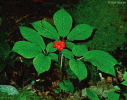|
American ginseng (Panaz quinquefolius) has been used
for the past 7,000 years in traditional Asian medicine. It is
prescribed for a variety of problems ranging from stress, falling
memory, obesity, exhaustion, immune booster, and fatigue. Some
also believe that it prevents certain cancers because it improves blood
circulation. Ginseng has been grown
in many parts of the world for hundreds of years. American
ginseng has only
recently been introduced to North America. It is currently being
grown in some areas of central United States and some areas of southern
Quebec and Ontario. It is now being examined as a crop which can
be grown in southern British Columbia. Currently, a few
operations have been started in the Lytton region, but I aim to find
out if this is the most suitable location to grow ginseng or if better
locations exist.
Ginseng is a difficult crop to grow because it must be grown for
at least four years to reach maturity. This means that the
environmental conditions have to be right all year round. This
can be problematic as winter conditions often bring cooler temperatures
and more precipitation, which can damage ginseng crops.
From literature, there are 2 different ways to grow ginseng. A
commercial grower's point-of-view or a traditional point-of-view.
The commercial growers view point is oriented at growing the largest
crop possible, with use of any other crop enhancement. Where as,
the traditional view point uses the natural environment to provide the
correct conditions.
My criteria are based on the environmental conditions that ginseng is
known to grow under. It generally prefers well drained
soil. It is a result of the molds that grow in moist soils and
the ability of diseases to develop and spread easier in moist
soils. A drier soil will prevent this from occurring, which is
extremely important, as four years of growing time can be completely
wasted by an entire crop being wiped out. This created one of my
criteria, less
precipitation provides better growing conditions. Freezing
temperatures can damage ginseng plants, and completely ruin an entire
crop. From literature, the air temperature can reach -4 C before
damaging the plant. This creates another criteria for my
analysis, the temperature must be above -4 C and the warmer the better
as it provided drier conditions. The slope of the land is the
basis for my next criteria. A slight slope will provide drainage,
but a steep slope will increase soil erosion. For the commercial
point-of-view, a lesser slope is necessary for machinery to be used on
the land. The most appropriate slope would be between 1 to 9
degrees. For the traditional point-of-view, a smaller slope is
beneficial for less soil erosion, but the range is slightly larger
because machinery is not used. The range can be from 1 to 15
degrees. The last criteria which was used for this analysis is
landcover. For the commercial point-of-view, any land cover which
is easy to cultivate is the most suitable, as long as it provides good
soil. This would be areas which do not need clearing or as much
cultivating. As for the traditional point-of-view, the most
suitable landcover is under trees. This provides shade for the
ginseng, an important environmental condition as direct sunlight can
burn the ginseng leaves. This is not an important factor in the
commercial point-of-view because they prefer to use man made covering
canopies to shade the ginseng and exact amount.
|
|
|



